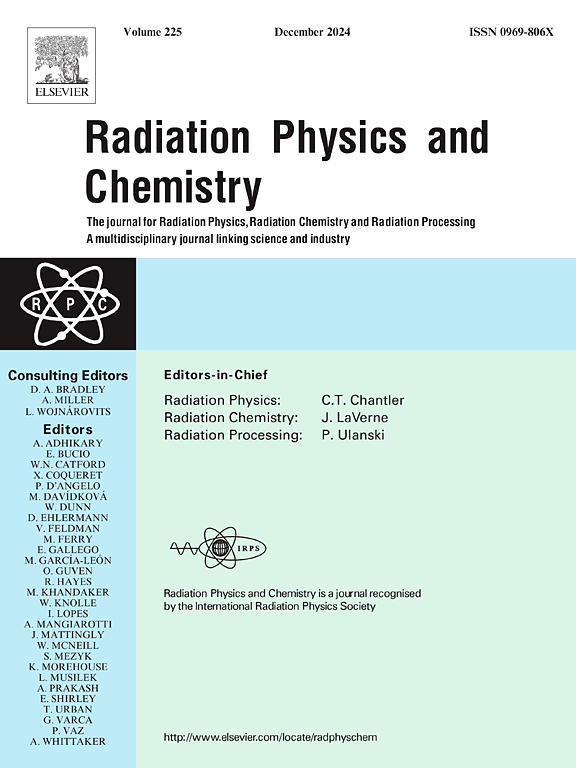用蒙特卡罗分析了用硅光电二极管进行放射治疗体内剂量测定的三维结构的可行性
IF 2.8
3区 物理与天体物理
Q3 CHEMISTRY, PHYSICAL
引用次数: 0
摘要
目的:本研究探讨了一种新型三维立方体装置的性能,该装置由六个BPW34S光电二极管(Vishay Semiconductors)组成,每侧一个,最近被提议用于体内剂量测定。方法:采用蒙特卡罗模拟程序FLUKA-CERN、TOPAS和PENH进行研究。在模拟中,3D剂量计被放置在水幻影的顶部,并被60Co光束和两束6MV和15MV的临床光子束照射。研究了探测器响应与光束入射角的关系。为了研究背散射辐射对探测器响应的影响,进行了不带光体的模拟。分析了探测器封装对其响应角依赖性的影响。此外,还研究了探测器的存在对幻体中吸收剂量产生的变化。结果:用三种蒙特卡罗代码得到了相似的结果。相对于使用单个光电二极管作为剂量计的情况,三维立方体探测器的角依赖性降低了。模拟结果与最近发表的初步实验数据基本一致。在包括封装在内的模拟中,剂量计响应的角依赖性显著降低。最后,已经发现三维探测器的存在产生了不可忽略的幻影表面吸收剂量的增加。结论:与单个光电二极管相比,由六个光电二极管组成的三维立方体探测器显示出明显较低的角依赖性。通过将剂量计嵌入具有适当厚度的包封物中,也可以大大降低角度依赖性。由于在临床应用中可能对患者皮肤产生影响,因此必须考虑表面吸收剂量的增加。本文章由计算机程序翻译,如有差异,请以英文原文为准。
A Monte Carlo analysis of the feasibility of a 3D structure build up with silicon photodiodes for in vivo dosimetry in radiotherapy
Purpose:
This study investigates the capabilities of a novel 3D cube device comprising six BPW34S photodiodes (Vishay Semiconductors), one on each side, recently proposed for in vivo dosimetry.
Methods:
The study has been conducted by using the Monte Carlo simulation codes FLUKA-CERN, TOPAS and PENH. In the simulations, the 3D dosimeter has been situated on top of a water phantom and has been irradiated with a 60Co beam and two clinical photon beams of MV and MV. The dependence of the detector response with the angle of incidence of the beam has been investigated. Simulations without the phantom have been done to study the effect of the backscattered radiation in the detector response. The effect of an encapsulation of the detector on the angular dependence ofits response has been also analyzed. In addition, the changes that the presence of the detector produces on the absorbed dose in the phantom have been studied.
Results:
Similar results have been obtained with the three Monte Carlo codes. The angular dependence of the 3D cube detector is reduced with respect to that found in case a single photodiode is used as dosimeter. The results of the simulations are in overall agreement with preliminary experimental data recently published. In the simulations carried out including the encapsulation, the angular dependence of the dosimeter response is significantly reduced. Finally, it has been found that the presence of the 3D detector produces a non-negligible increase of the absorbed dose at the phantom surface.
Conclusions:
The 3D cube detector constructed with six photodiodes, one in each of its faces, shows a significantly lower angular dependence in comparison to a single photodiode. The angular dependence can also be strongly reduced by embedding the dosimeter in an encapsulation with the appropriate thickness. The increasing of the absorbed dose at the surface must be considered because of the possible effects it could produce in the skin of patients in clinical applications.
求助全文
通过发布文献求助,成功后即可免费获取论文全文。
去求助
来源期刊

Radiation Physics and Chemistry
化学-核科学技术
CiteScore
5.60
自引率
17.20%
发文量
574
审稿时长
12 weeks
期刊介绍:
Radiation Physics and Chemistry is a multidisciplinary journal that provides a medium for publication of substantial and original papers, reviews, and short communications which focus on research and developments involving ionizing radiation in radiation physics, radiation chemistry and radiation processing.
The journal aims to publish papers with significance to an international audience, containing substantial novelty and scientific impact. The Editors reserve the rights to reject, with or without external review, papers that do not meet these criteria. This could include papers that are very similar to previous publications, only with changed target substrates, employed materials, analyzed sites and experimental methods, report results without presenting new insights and/or hypothesis testing, or do not focus on the radiation effects.
 求助内容:
求助内容: 应助结果提醒方式:
应助结果提醒方式:


